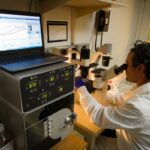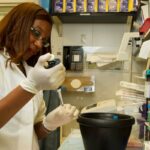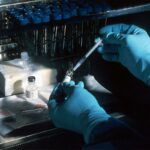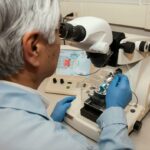The concept of DNA theft might sound like a plot straight out of a science fiction novel, but it is a real phenomenon that occurs in nature. DNA, the fundamental building block of life, is not just susceptible to damage and mutation, but also to theft. Understanding DNA theft is crucial as it can shed light on various biological processes, including evolution, disease progression, and even the development of new biotechnological tools.
The Science of DNA: A Brief Recap
DNA, or deoxyribonucleic acid, is the molecule that carries the genetic instructions for the development, functioning, growth, and reproduction of all known organisms and many viruses. DNA molecules are double-stranded helices, with each strand composed of a sequence of nucleotides. This sequence is what encodes genetic information.
The role of DNA in genetic information transfer is fundamental. DNA replication, a process where a DNA molecule is copied, is the basis for biological inheritance. The copied DNA is passed on from parents to offspring, ensuring the continuity of genetic information.
Viruses and DNA Theft
Viruses, nature’s ultimate pirates, are known to steal DNA from their hosts. A virus cannot reproduce on its own; it needs to hijack a host cell’s machinery to replicate. During this process, it often incorporates the host’s DNA into its own genetic material, effectively stealing it.
The process of DNA theft differs between eukaryotic and bacterial viruses. Eukaryotic viruses, such as the Human Immunodeficiency Virus (HIV), integrate their genetic material into the host’s DNA. In contrast, bacterial viruses, or bacteriophages, can carry pieces of their previous host’s DNA and transfer it to the next host, a process known as transduction.
The implications of viral DNA theft are significant. It can lead to the emergence of new viral strains, contribute to the spread of antibiotic resistance, and even drive evolution.
The Case of Viruses: Host Specificity in DNA Theft
Not all viruses can infect all types of cells. Viruses are host-specific, meaning they can only infect specific types of cells. This host specificity also applies to DNA theft. Viruses can only steal DNA from the cells they can infect.
The limitations of viral DNA theft are largely determined by host specificity. For instance, a virus that infects bacteria cannot steal DNA from a human cell. However, within their host range, viruses can potentially steal any piece of DNA, contributing to genetic diversity and evolution.
Beyond Viruses: Other Entities That Steal DNA
While viruses are the most well-known DNA thieves, they are not the only ones. Other entities, including bacteria and even some multicellular organisms, can also steal DNA.
For instance, bacteria can acquire DNA from their environment, a process known as transformation. Some plants and animals are also capable of horizontal gene transfer, a process similar to DNA theft. For example, the sweet potato has naturally incorporated genes from bacteria into its genome.
DNA Theft in Horizontal Gene Transfer
Horizontal gene transfer (HGT) is the transfer of genetic material from one organism to another that is not its offspring. This is different from the traditional vertical transfer of genes from parent to offspring. DNA theft plays a significant role in HGT.
Bacteria, for instance, can pick up DNA from their environment and incorporate it into their own genome. This process, known as transformation, is a form of DNA theft. It is one of the ways bacteria can acquire new traits, such as antibiotic resistance.
The Impact of DNA Theft on Evolution
DNA theft can drive evolution by introducing new genetic material into an organism’s genome. This can lead to the development of new traits, which can be beneficial or detrimental.
For example, the acquisition of antibiotic resistance genes by bacteria is a form of evolution driven by DNA theft. On a larger scale, the incorporation of viral DNA into the human genome has been suggested to play a role in the evolution of our species.
DNA Theft in Genetic Engineering and Biotechnology
The principles of DNA theft have been harnessed in genetic engineering and biotechnology. Scientists can introduce new genes into organisms, effectively “stealing” the function of these genes.
However, the use of DNA theft techniques in biotechnology is not without challenges. Issues such as off-target effects, where the introduced DNA integrates at unintended sites, and the potential for unintended consequences, such as the creation of new pathogens, need to be addressed.
Ethical Considerations of DNA Theft
The concept of DNA theft raises several ethical issues. For instance, should we be manipulating the genomes of organisms in this way? What are the potential consequences for the environment and biodiversity?
There is also the issue of genetic privacy. With the rise of genetic testing and personalized medicine, who owns our genetic information, and who has the right to access and use it?
Future Directions in DNA Theft Research
Research into DNA theft is still in its early stages, but it is a rapidly growing field. Future research will likely focus on understanding the mechanisms of DNA theft, its role in evolution, and its potential applications in biotechnology.
Potential breakthroughs in this field could have significant implications. For instance, a better understanding of how viruses steal DNA could lead to new antiviral strategies. Similarly, advancements in our ability to manipulate genomes could revolutionize biotechnology and medicine.
Key Takeaways
Key Takeaways, DNA theft is a fascinating and complex phenomenon that plays a crucial role in biology. From driving evolution to shaping the future of biotechnology, understanding DNA theft can provide insights into the fundamental processes of life.
While there are still many unanswered questions and ethical considerations, one thing is clear: DNA theft is a powerful force in nature, and understanding it can open up new frontiers in science and medicine.
Frequently Asked Questions
What is DNA theft?
DNA theft refers to the process where an organism or entity incorporates foreign DNA into its own genetic material.
How do viruses steal DNA?
Viruses steal DNA by incorporating the host’s DNA into their own genetic material during the replication process.
Are viruses the only entities that can steal DNA?
No, other entities such as bacteria and even some multicellular organisms can also steal DNA.
What is the role of DNA theft in evolution?
DNA theft can drive evolution by introducing new genetic material into an organism’s genome, leading to the development of new traits.
How is DNA theft used in biotechnology?
In biotechnology, scientists can introduce new genes into organisms, effectively “stealing” the function of these genes.
What are the ethical considerations of DNA theft?
Ethical considerations of DNA theft include issues related to manipulating the genomes of organisms, potential consequences for the environment and biodiversity, and concerns about genetic privacy.
References:
- Gogarten, J. P., & Townsend, J. P. (2005). Horizontal gene transfer, genome innovation and evolution. Nature Reviews Microbiology, 3(9), 679-687.
- Lander, E. S., Linton, L. M., Birren, B., Nusbaum, C., Zody, M. C., Baldwin, J., … & Funke, R. (2001). Initial sequencing and analysis of the human genome. Nature, 409(6822), 860-921.
- Kyrou, K., Hammond, A. M., Galizi, R., Kranjc, N., Burt, A., Beaghton, A. K., … & Crisanti, A. (2018). A CRISPR–Cas9 gene drive targeting doublesex causes complete population suppression in caged Anopheles gambiae mosquitoes. Nature biotechnology, 36(11), 1062-1066.
- Caplan, A. L., Parent, B., Shen, M., & Plunkett, C. (2009). No time to waste—the ethical challenges created by CRISPR: CRISPR/Cas, being an efficient, simple, and cheap technology to edit the genome of any organism, raises many ethical and regulatory issues beyond the use in humans. EMBO reports, 16(11), 1421-1426.








